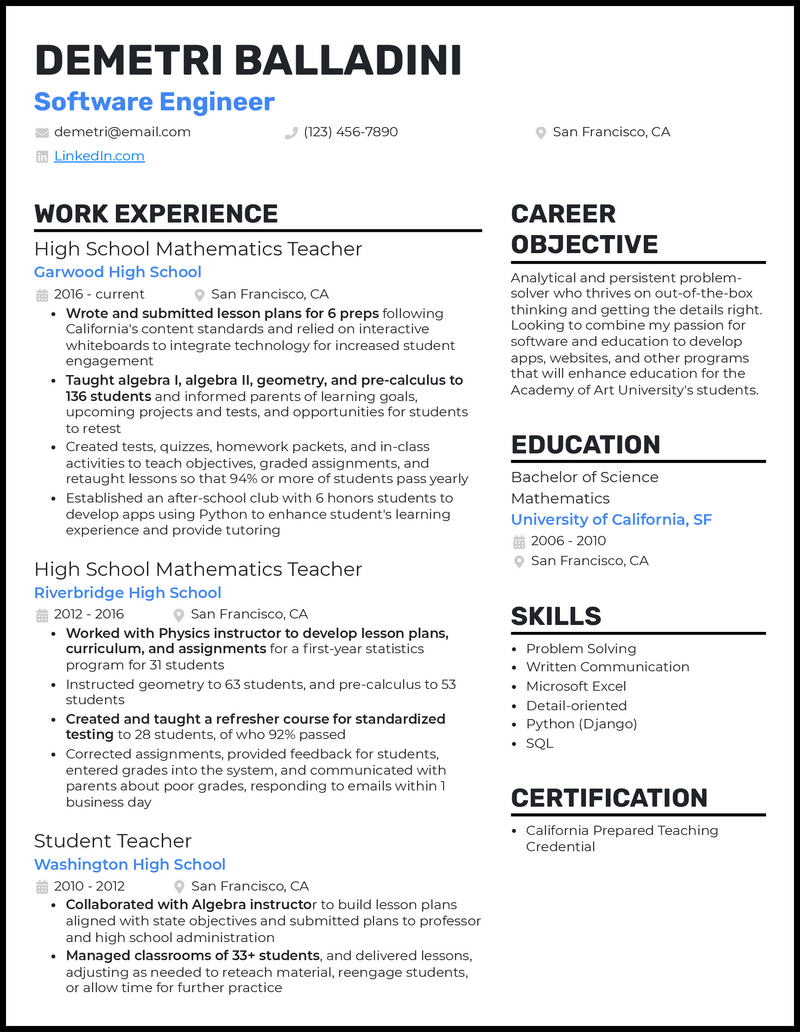
Teacher Career Change





Best for professionals eager to make a mark
Resume Builder
Like this template? Customize this resume and make it your own with the help of our Al-powered suggestions, accent colors, and modern fonts.
If you’re a teacher transitioning out of education, your main focus shouldn’t be having experience, but transferable skills. You already have the right soft skills needed for your new role. The key here is to reframe your teaching background so HRs immediately understand your impact.
Simply looking at other teacher career-change resume examples won’t be enough. You must learn the best formatting tips to build your next cover letter or resume. That’s why we’ve prepared this guide. We’ll provide you with:
- ↪ The best resume templates for pivoting into another role
- ↪ Strategies for quantifying your teaching experience
- ↪ Enclosures that prove you’re more than ready to switch careers.
Why this resume works
- Depending on the field you’re entering, include skills in your teacher career change resume that aren’t expected from a beginner. For example, add Python and SQL to show the employer you know the nitty-gritty of software engineering. Add more finesse by treading the fine line and add a skill that’s important in both teaching and your desired role: problem-solving is a befitting example here.
Related resume examples
How to Write a Teacher Career Change Resume

Since you’re switching roles, including a career objective will be your first task. Pair it with some strong, transferable skills and craft strong SWE sections that are tailored to specific jobs.
These are just some of the many things you need to prepare before writing a resume. This section will cover:
- Tips on writing a compelling career change resume objective
- Crafting your education and certification section for specific roles
- A list of transferable skills you can include

How do you write a teacher career-change resume objective?
When you switch careers or enter the workforce for the first time, it’s recommended to include a career objective that describes your best bits. As a rule of thumb, ensure you:
- Communicate your transferable skills
- Frame your transition clearly
- Show enthusiasm and direction
As a teacher, you already have a way with words, and only need to ink out your passion for a new job. Below, we’ve shared an example of how you can write one.
Example career objective of a former teacher:
High school English teacher transitioning into project coordination. Skilled in task management, leading teams, and delivering results in high-pressure environments. Looking to apply my strengths in tools like Jira and Asana to support daily operations at Honeywell.
Notice how simple these few lines are? That’s what you need as well. From their former career to skills they can apply in the next job and their reason to apply, this candidate nails this section with just three sentences.

How to demonstrate your transferable skills
Your skills section might seem a bit confusing at first if you’re switching careers—do you list skills related to your old job, or the new one? Well, it’s a bit of both! You want to prove that you’ve mastered the general essentials of teaching as they apply to the career you’re switching to.
Recruiters want to see skills that relate directly to the role you’re applying for, so avoid including subject-specific points from your previous role unless they overlap with the new job’s description. If you’re aiming to work in software development, don’t emphasize English teaching skills!
And ensure that you’re as specific as possible, especially with your soft skills and software tools. Name your favorite programs, and spell out exactly how you’re good at interacting with others.
Check out these examples:
9 most popular teacher career change skills
- Problem-solving
- Project Planning
- Data Presentation
- Python
- SQL
- MS Excel/PowerPoint
- MongoDB
- Java
- Linux

Sample teacher career change work experience bullet points
Now that you’ve told recruiters how you’ve taught and helped students, it’s time to cite examples of the times you’ve fostered a successful group environment in the past! Think of ways your past teaching accomplishments can suggest future achievements in different settings.
If you use to teach history and are pursuing a career change to become a real estate agent, think of experience examples that feature things like lesson adjustments (which are parallel to customizing lease agreements). Or think of things more technically and share stories about how you helped others overcome obstacles.
No matter what you’ve taught or helped your students achieve, you’ll need to give recruiters some solid metrics for your success! You can make any AI resume unique by using quantifiable data to back your claims—especially if you have satisfaction or engagement rates that would transfer well to other jobs.
Here are some good examples:
- Created and taught a refresher course for standardized testing to 28 students, 92% of which passed
- Established an after-school club with honors students to develop apps using Python to enhance students’ learning experience and provide tutoring that resulted in an 11% increase in engagement
- Worked with physics instructor to develop lesson plans, curriculum, and assignments for a first-year program for 31 students, resulting in a grade average of B+
- Created tests, quizzes, homework packets, and in-class activities to teach objectives, re-teaching lessons to ensure that a student passing rate of 94% or more

How should teachers craft their education section?
As someone who passes knowledge to the next generation, your degree does matter a lot in your resume. If your degree connects, even indirectly to the role you’re targeting, you’ll boost your chances of landing the job.
Not sure how to format it? Follow the example below that shows the education section of a Math teacher:
Example
Bachelor of Science
Mathematics
University of California
2006 – 2010
San Francisco, CA
Using an AI resume builder to complete this section is best since it gives you clear instructions on where you need to include your degree name, GPA (if 3.4 or above), dates, etc.

Should teachers include courses or certificates?
Yes! Your teacher career change resume must mention at least a course or certificate. It’s best if you can include one related to the role, but there are also common certs that can do the job, such as:
It’s fine to even include certifications/courses you’re still pursuing. It gives employers an idea that you’re actively making efforts to upskill.

How do teachers tailor resumes to corporate, HR, or project management roles?
The best way to tailor your resume to a specific role is to speak the company’s language. Depending on the type of industry you enter, you can use specific keywords that improve your credibility.
For example:
- Corporates focus on process improvement, reporting, SOPs, and logistics.
- HR values onboarding, training, and conflict resolution skills.
- Project management should have time management and cross-functional coordination.
Pro tip: Not sure which keywords to include? Read the job description to get an idea of the words your to-be company uses.

Should teachers include classroom management on a resume?
Having classroom management in your resume is fine, as long as you word it correctly. Ideally, you want to have some level of corporate wording to appeal to employers.
So don’t say you:
- Handled student behavior
- Helped with assignments
- Stopped fights
Instead, say you:
- Supervised students to keep disruption at a minimum
- Guided groups to improve project/assignment
- Resolved conflicts among students
Top 5 tips for your teacher career change resume
- More on transferable metrics:
- Remember: Just because your focus should be on the career you’re aiming for doesn’t mean you can’t include great points from previous class experiences! Things that carry over well across fields include test score increases, student engagement percentages, and feedback ratings. These show your ability to foster individual and group success.
- Use a super-organized template
- Any of our templates will help you make your qualifying teaching experiences look good, but pick whichever one makes the big picture look downright great! Make sure each section is clear, with a good hierarchy in your resume layout so that recruiters have an easy time skimming over what qualifies you for your new role.
- Weigh your objective
- A career switch is a great time to utilize a handy resume objective! Just make sure your objective statement is concise and packed with new, valuable information about your personal selling points. Focus on stepping into your new job, and avoid listing teaching-related points that you’re planning to address later.
- Show off your technical skills
- Even if many of your experience points naturally relate to your previous area of expertise in the classroom, your skills section can include software and interpersonal abilities that speak more to your qualification for the new role. Showcase any instances when you utilized objective, technical skills behind-the-scenes in your previous job, too!
- Use compelling metrics
- Switch up your metrics to keep things interesting and show how well-rounded your abilities are. Whenever possible, tie them in with the new job role you’re applying for through context or relevant backstory, like tutoring classes you led or group projects that involved specific programs.

What mistakes do teachers make when switching careers?
There are a lot of mistakes you can make on your resume while changing careers as a teacher, and that’s fine! What’s not fine is learning about them and repeating those mistakes. So, here are a few common mistakes you should avoid to get your next job:
- Including teaching-specific jargon
- Listing daily class tasks instead of outcomes
- Excluding transferable skills
- Skipping certificates and/or courses

Key takeaways
- Translate your teaching experience to the role.
- Use a strong career objective to stand out.
- Quantify bullet points to show your results as a teacher.
Teacher Career Change Resume FAQs

The best option for a teacher career change resume is to use a reverse-chronological format. This format places your most recent work experiences at the top, giving employers a quick look into your best skills and capabilities.
You want your resume to look modern, clean, and professional. If you want to use a little bit of color as a highlight here and there, go for it, but avoid anything that distracts from what makes you perfect for the new job. Use sleek fonts for readability, too!
By using keywords directly mentioned in the job description of your teaching role. Words and phrases such as “Classroom management,” “Bachelor’s in Education,” and “Student-centered learning” are common in teaching job listings. Find such keywords and naturally add them to your resume.
While this may vary, stick with one page and one page only! Anything on page two is unlikely to get through anyway—recruiters really prefer short resumes that are quick to read through. And concision shows your ability to adapt smoothly during your transition to a totally new career.













